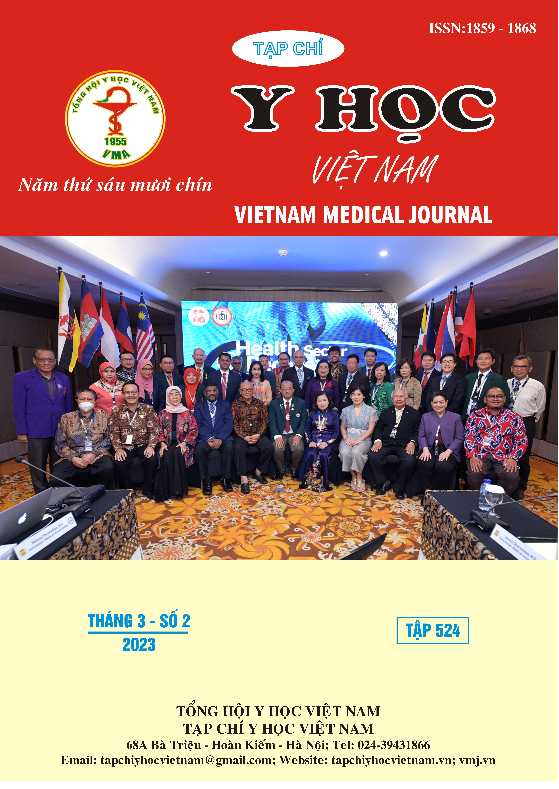KHẢO SÁT TẦN SUẤT TIÊU THỤ CÁC NHÓM THỰC PHẨM CỦA NGƯỜI CAO TUỔI TẠI TỈNH TRÀ VINH
Nội dung chính của bài viết
Tóm tắt
Mục tiêu: Khảo sát tần suất tiêu thụ các nhóm thực phẩm của người cao tuổi tại tỉnh Trà Vinh. Phương pháp nghiên cứu: Nghiên cứu cắt ngang mô tả được sử dụng trên 627 người cao tuổi tại tỉnh Trà Vinh từ 01/10/2021 đến 30/07/2021. Bộ câu hỏi Bảng tần suất tiêu thụ thực phẩm (Food Frequency Questionnaire: FFQ) được sử dụng để khảo sát tần suất tiêu thụ thực phẩm và so sánh với Tháp dinh dưỡng hợp lý cho người trưởng thành của Viện Dinh dưỡng quốc gia Việt Nam cũng như khảo sát mối liên quan với tình trạng suy dinh dưỡng theo MNA-SF (Mini Nutritional Assessment –Short form: Bộ công cụ đánh giá dinh dưỡng Mini – Mẫu ngắn). Kết quả: Nhóm đồ uống: đối tượng có độ tuổi từ 60-69 tuổi có tần suất tiêu thụ cao nhất (TV = -0,45); tiếp đến là đối tượng có độ tuổi từ 70-79 tuổi có tần suất tiêu thụ (TV = -0,43) và nhóm đối tượng từ tuổi ≥ 80 tuổi có tần suất tiêu thụ thấp nhất (TV = -0,77), sự khác biệt có ý nghĩa thống kê với p = 0,018. Nhóm sữa: đối tượng có độ tuổi ≥ 80 tuổi có tần suất tiêu thụ thấp hơn (TV = -0,39) so với nhóm 70-79 tuổi (với TV = -0,18) và nhóm 60-69 tuổi (với TV = -0,13), sự khác biệt có ý nghĩa thống kê với p = 0,048. Nhóm thực phẩm chế biến sẵn: đối tượng 70-79 tuổi và nhóm từ 80 tuổi trở lên có tần suất tiêu thụ tương đương nhau (TV = -0,59 và TV = -0,58); thấp hơn nhóm đối tượng 60-69 tuổi (TV = -0,38), sự khác biệt có ý nghĩa thống kê với p = 0,024. Kết luận: Tần suất tiêu thụ các nhóm thực phẩm ở nhóm ≥ 80 tuổi giảm hơn so với các nhóm tuổi còn lại, ngoài ra tần suất tiêu thụ các thực phẩm đều chưa đáp ứng theo Tháp dinh dưỡng hợp lý cho người trưởng thành của Viện Dinh dưỡng quốc gia Việt Nam. Đa số các nhóm thực phẩm đều đóng góp vào tình trạng dinh dưỡng theo MNA-SF của người cao tuổi (với p < 0,05).
Chi tiết bài viết
Từ khóa
dinh dưỡng người cao tuổi, FFQ, tháp dinh dưỡng, Trà Vinh
Tài liệu tham khảo
2. Hà Thị Ninh và cộng sự, "Tình trạng dinh dưỡng người cao tuổi huyện Mỏ Cày Bắc tỉnh Bến Tre năm 2011", Tạp chí Y học Thành phố Hồ Chí Minh, 2011, Tập 18 (Số 6).
3. Nguyễn Bách, Nguyễn Đức Công, Vũ Đình Hưng, Liên Châu Thị Kim, "Đặc điểm về rối loạn nước và điện giải trong Suy thận cấp ở người lớn tuổi", Tạp chí Y Dược TP Hồ Chí Minh, 2012,16 (01), trang 185-189.
4. Nguyễn Thị Nhật Tảo, Phạm Thị Lan Anh và cộng sự, "Tỷ lệ suy dinh dưỡng và một số yếu tố liên quan ở người cao tuổi dân tộc Khmer tại huyện Trà Cú, tỉnh Trà Vinh năm 2020", Y học Dự Phòng Việt Nam, 2021, 3 (31), trang 121-128.
5. Tổng cục Thống kê. Thông cáo báo chí Kết quả Tổng điều tra Dân số và Nhà ở năm 2019. Trung tâm Tư liệu và Dịch vụ Thống kê, 2019.
6. Drewnowski A, Evans W. J, "Nutrition, physical activity, and quality of life in older adults: summary", 2001, 56 (suppl_2), pp. 89-94.
7. Wilma Leslie, Catherine Hankey, "Aging, nutritional status and health", Healthcare, 2015, 3 (3), pp. 648-658.


